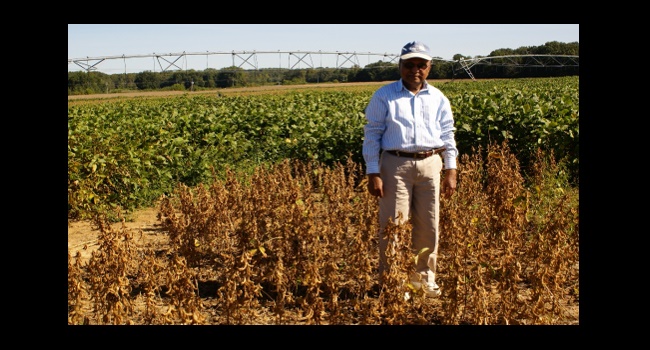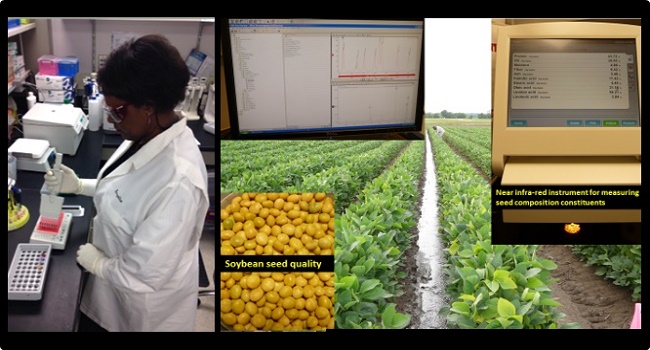Photo Carousel Links
Integrating host plant resistance into reniform nematode management of cotton (provided by Dr. Sally Stetina).
Research of introgressing exotic germplasm into Upland cotton (provided by Dr. Linghe Zeng, left photo). Identifying and transferring into adapted cotton lines, naturally occurring traits that improve the cotton plant’s self protection mechanisms, commonly referred to as host plant resistance (HPR) (provided by Dr. Jodi Scheffler, pictured in right photo).
Cotton leaf trichomes on DP5690 (provided by Dr. Rickie Turley, left photo). Tufted-naked seed germplasm 9023n4t, developed from wild type SC 9023 through chemical mutagenesis (provided by Dr. Efrem Bechere, right photo collage).
Population development for genetic characterization of reniform nematode resistance (provided by Dr. John Erpelding).
Advancing soybean lines in the station yield test at Milan, TN developed with newest source PI494182 having broad Soybean Cyst Nematode (SCN) resistance (provided by Dr. Prakash Arelli, pictured).
Soybean DS25-1 with Tolerance to Mature Seed Damage Released 2017 displaying damage sensitive seed (left) and damage tolerant seed (right) (provided Dr. James R. Smith).
2015 Southern Soybean Breeders Tour participants observing Uniform Soybean Tests – Southern States field trials planted and at Stoneville, MS. by Dr. Anne M. Gillen. Hosted by Drs . Anne M. Gillen and James R. Smith (left photo by Mr. Hans Hinrichsen). Phomopsis seed decay caused primarily by the fungus Phomopsis longicolla (provided Dr. Shuxian Li, right photo).
Soybean Molecular Genetics (A. Davis pictured left, provided by Dr. J. Ray). Soybean breeding lines with desirable physiological & genetic traits investigated to quantify contribution effects to seed quality, composition constituents & mineral nutrients under drought & high heat in midsouth (provided by Dr. N. Bellaloui, right photo collage).
Host-pathogen interaction between charcoal rot, frogeye leaf spot & soybean to identify new resistant sources using improved screening methods. New germplasms with more durable resistance to these predominant pathogens will result in economically & environmentally sustainable soybean production in US and Worldwide (provided by Dr. A. Mengistu).
Mission
The mission of the Crop Genetics Research Unit is to (1) develop knowledge of the biology of cotton and soybean plants including their genetic, physiological, and pest resistance interactions with the environment; (2) discover heritable plant characteristics that confer resistance or tolerance to adverse environmental pressures, pests and diseases and improve quality; (3) coordinate the National Cotton Variety Tests and the Uniform Soybean Tests for the southern U.S.; (4) maintain and evaluate a soybean germplasm collection; (5) release improved germplasm, and use this knowledge and new germplasm to enhance production and improve the environment.









